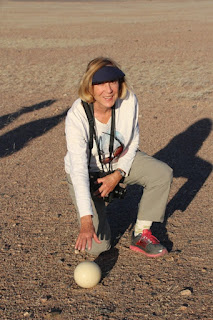We have come to Namibia to see the magnificent red
sand dunes, and this is the day.
 |
| The sand takes on a red hue as the morning sun rises. |
Sossusvlei comes from the native words sosses
meaning “land of no return” and vlei meaning “dry place.” It’s an apt
description of the place where the Namib desert’s dunes come together and
prevent the Tsauchab River from flowing to the Atlantic Ocean. The result is a
large salt-filled pan surrounded by enormous mountains of golden sand in the
heart of the Namib.
 |
| For perspective on how high the dunes are, notice the people climbing this dune. |
It does not disappoint.
Dawn and dusk provide the best opportunities for
spectacular photography, and we didn’t let the morning light go to waste. We
snapped photos of classically curved dunes from numerous angles. Every few
minutes as we drove along there was another majestic dune to photograph.  |
| We walk in footsteps before they are blown away by the wind. |
After driving by the park’s first dune and seeing a
full parking lot because many people had stopped there, we decide to go further
and soon are rocking and rolling through the deep sand. Only four-wheel drive
vehicles are allowed as it’s easy to get stuck in this terrain.
Arriving at
the dune called Big Daddy, we choose an “arm” or extension to hike. About
halfway up, the wind begins to blow hard, spraying sand on our cameras and
stinging our faces. In single file we chug through the steep climb, balancing
in our steps in the soft, moving sand.  |
| Below the dune in the dry salt pan. |
The key is to step in footprints left by another
hiker. Getting off the path could mean getting stuck in the cavernous,
quick-sand-like surface. The problem is
that these footprints disappear quickly in the strong wind. In fact, a sandy fog
is created by wind at the top and subsequently hampers our view of stunning
landscapes.
At the top of the dune, we remove our shoes and
socks and step gingerly off the ridge onto the shadowy slip face, sinking to
mid-calf in the warm, fluffy sand. Despite walking slowly (our guide is quite
practiced and scampers down in a matter of minutes), at one point I falter and
catch myself with the hand carrying my hiking boots, thus filling them with
more sand.
 |
| Vegetation cannot survive in the harsh conditions of the salt pan. |
At the bottom we find ourselves wandering around a
portion of the huge salt pan. Any trees that had grown there are now merely
ghostly branches. But we have a chance to look back up where we had been—a truly
mesmerizing sight and a highlight of the day’s adventure. My bucket list just
got shorter.
Photos by Larry and Beverly Burmeier


































